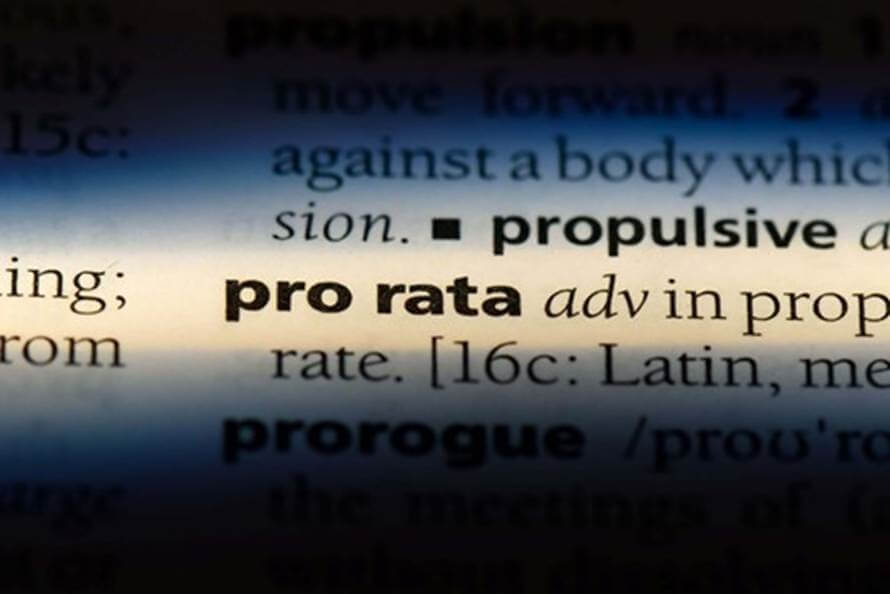Croner covers all the pro-rata essentials for employers, including how to calculate pro rata salary, who qualifies for pro rata salary, pro-rata for a part time working pattern, and how to calculate it for holiday entitlements.
As an employer you've undoubtedly heard the term ‘pro rata', but do you know exactly what it means and how to work out pro-rata pay and holiday entitlement calculations for your employees?
In this article, we'll be taking a look at the calculations you need to make, as well as other areas you need to consider when employing someone pro rata. Like with all aspects of payroll and annual leave, you should ensure that these calculations are correct and fair or you could find your business on the end of a legal dispute at an employment tribunal.
For immediate pro rata salary and holiday entitlement support, get in touch with a member of our expert HR advisory team on 01455 858 132.
- What is pro rata salary?
- How to work out pro rata salary
- How to work out pro rata wages
- How to work out pro rata holiday
- Working on a pro rata basis: benefit entitlements
- Need help calculating pro-rata salary or holidays?
What is pro rata?
The Latin word ‘pro rata’ when translated to English means ‘proportional’. So, to prorate is the act of dividing an object into equal portions depending on an individual’s share of the overall object.
Whilst this term is most seen in an employment setting, it’s also used to calculate insurance premiums, and interest rates.
So, what does on a 'pro-rata basis' mean? It’s the proportion upon which you calculate pro rata. It applies to the distribution of a sum across a number of units. For example, when you give something to a group of people on a pro-rata basis, it involves assigning a value to each person depending on their share of the whole.
Who does pro rata annual salary apply to?
In layman’s terms a pro rata salary is a salary in proportion to a factor, such as:
- The number of working days in leave years.
- The number of hours worked equivalent to full time hours.
For example, if an employee's salary would be £26,000 pro rata in a 40-hour week, but they only work 30 hours a week, their annual salary would be £19,500.
So, someone who works ‘pro rata' is getting a proportion of a full-time salary.
Working part-time in a business
Part-time staff receive a proportionate amount of pay compared to a full-time employee. The person will have the same skillset as an employee with a full-time role (40 hours a week) and will perform it the same. However, they will work that role within part-time hours, i.e., for a smaller amount of time (20 hours a week).
Part-time employees work less than 35 hours per week and receive the same salary as a full-time employee on a pro-rata basis.
Note: There are no legal definitions of ‘full-time’ and ‘part-time’. The hours associated with both will depend on your industry and business type.
Joining a company in the middle of a pay period
If you take on an employee after your payroll cut-off then that employee still needs to be paid. Because they have joined your business in the middle of the month, the salary they receive on their first payslip will be on a pro rata basis for the days they have worked.
Resignation or dismissal in the middle of a pay period
This would work the same as a new starter joining your organisation in the middle of a pay period.
For employees who either resign or are dismissed, their final pay slip will be their normal remuneration but calculated on a pro-rata basis for the days worked.
Being promoted in the middle of a pay period
Let’s say you have an outstanding employee who you want to promote. If that promotion is granted in the middle of a pay period and it comes with a salary increase, then the new salary may need to be paid on a pro-rata basis.
So, the employee would get their previous rate for the days worked and the new rate for the remaining days worked in that pay period.
Working for a specific period
An employee may only work for your business for a short duration. For example, this might happen if another team completes a set of tasks. In that instance, your company would pay the fixed term employee's salary on a pro-rata basis.
Unpaid leave
Your contracts and documentation will outline your sick leave pay policy, annual leave policy (paid time off) and any other leave (such as maternity, paternity or bereavement).
Every company has their own set of paid leave terms. If an employee has exhausted their annual leave and you agree to unpaid time off, their salary would then be paid on a pro-rata basis to reflect this.
No business wants to end up facing an employment tribunal, so let’s discuss how to get pro-rata right. Call 01455 858 132.

How to work out pro rata salary
The basic calculation below uses a simple equation, and you can use it to work out pro-rata salary:
- Annual salary / full-time hours x actual work hours
The output value isn't always 100 percent accurate. The better way to calculate pro rata pay entitlement is to work it out by the actual hours worked, rather than days.
In other words, it's more helpful to think about it as a wage, rather than a salary.
How to work out pro rata wages
If an employee would receive £500 for a 40-hour week, then you can easily work out the hourly rate, which is £500 / 40 = £12.5.
Once you've figured out the hourly rate, you should be able to reach the pro rata wage just by multiplying the hourly rate by the number of actual hours the employee will work. For example:
- 30 hours x £12.5 = £19,500 per annum.
If you're still struggling with how to work out pro-rata pay, remember the basic equation: Annual salary / full-time hours x actual work hours.
Does pro rata salary impact annual holiday entitlement?
One of the trickiest things to factor in when working out pro rata salary is including bank holidays and holiday entitlement.
Pro rata holiday entitlement is the amount of holiday that an employee will get in proportion to the holiday entitlement of a full-time employee, or an employee who had joined your organisation in the middle of a pay period.
All employees are entitled to statutory minimum paid holiday, but with pro rata salaried staff it impacts everything from bank holiday entitlements to how much annual leave allowance is granted.
- How much holiday part-time workers receive will depend on the number of hours and days a week your employee works.
- An employee is entitled to receive the statutory minimum holiday entitlement of 5.6 weeks.
If a full-time employee works 5 days per week that’s a minimum of 28 days leave, which can be inclusive of bank holidays. If your part-time employee works exactly half as much, they are legally entitled to half as much holiday on a pro-rata basis which in this case would be 14 days.
There are a few different scenarios to consider when you calculate pro-rata holiday entitlement. Calculating holiday pay is straightforward once you know how.

How to work out pro rata holiday
A part-time employee still has holiday entitlement, referred to as statutory entitlement. Let's work that out below using an example.
- Multiply the number of days they work each week by 5.6.
- If a pro rata employee works 3 days a week, then their holiday entitlement is 3 x 5.6, or 16.8 days.
Obviously, giving staff 0.8 of a holiday is awkward, for timekeeping purposes and the employee. That’s why it is usually worth rounding this up to the nearest whole number, 17 in this case.
Why the 5.6 multiplier?
Well, the basic statutory holiday entitlement of a full-time employee is 28 days (5.6 weeks). This means they work five days a week.
5, multiplied by 5.6, gives us the full 28 days' entitlement without the need for a decimal point.
Working on a pro rata basis: benefit entitlements
Another important element to consider when employing someone on a pro-rata basis is benefits.
The Part-Time Workers Regulations state that those on a part-time income should receive the same benefits as those working full-time. What this means is that if you offer a pension to full-time employees, then you must also offer this to those working pro rata.
The list of fair compensation doesn't stop at pay-related benefits either. If full-time employees get a gym membership or their birthday off as annual leave, those on part-time should too.
Need help calculating pro-rata salary or holidays?
Avoid the hassle by using a pro rata calculator online. An example of a salary calculator can easily be found online. Remember, if you're calculating salary using a pro rata salary calculator online, you'll also need to calculate holiday entitlement.
Speak to a Croner expert today and get advice on pro-rata employment contracts, maternity pay working hours, pay, payslips and employee benefits.
Croner has been helping businesses with their HR, Employment Law and Health and Safety needs for over 80 years. Call today on 01455 858 132
Related resources
Categories
- Business Advice
- Culture & Performance
- Disciplinary & Grievances
- Dismissals & Conduct
- Employee Conduct
- Employment Contracts and Documentation
- Employment Law
- Employment Rights Bill
- End of Contract
- Equality & Discrimination
- Health & Safety
- Hiring and Managing
- Leave & Absence
- Managing Health & Safety
- Moving
- Occupational Health
- Pay & Benefits
- Recruitment
- Risk & Welfare




